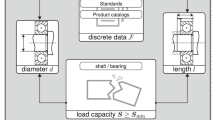Abstract
Despite its significant effect on the weight and dynamic performance of a gear system, the topology of the gear blanks, including the geometry and dimensions of the hub, the web and the spokes, has not been systematically studied. The occasional investigations of the subject have been mainly experimental and/or based on simplifying assumptions. This paper presents a simulation-based approach to the optimal shape design of gear-blank lightening holes. A set of parametric curves is used to describe the hole geometry. The optimum coordinates of the curves’ vertices are then determined through a multi-objective optimization procedure that would minimize the weight of the gear and the maximum-to-minimum stress ratio while satisfying strength and performance requirements. As its function evaluation engine, the optimization algorithm employs a neural network which is trained using results from a uniformly distributed set of FE simulations. Multiple case studies show an average of 23 % weight reduction compared to traditionally designed gear holes.













Similar content being viewed by others
Notes
Tan-sigmoid function with the relationship of \(y = \frac{2}{{1 + e^{ - 2x} }} - 1\).
References
Ahn YJ, Kim HO, Lee KY (1998) G1 Arc sp-line approximation of quadratic Bezier curves. Comput Aided Des 30(8):615–620
Atanasovska I, Nikolić V (2007) 3D spur gear FEM model for the numerical calculation of face load factor. J Facta Univ Ser 6(1):131–143
Buiga O, Popa CO (2012) Optimal mass design of a single-stage helical gear unit with genetic algorithms. Proc Rom Acad Ser A Math Phys Tech Sci Inf Sci 13(3):243
Chaari F, Fakhfakh T, Haddar M (2009) Analytical modeling of spur gear tooth crack and influence on gear-mesh stiffness. Eur J Mech A Solids 28(3):461–468
Faggioni M, Samani F, Bertacchi G, Pellicano F (2011) Dynamic optimization of spur gears. J Mech Mach Theory 46(4):544–557
Farin G (1997) Curves and surfaces for computer aided geometric design: a practical guide. Academic Press, Dublin
Goldberg D (1989) Genetic algorithms in search and machine learning, reading. Addison Wesley, Boston
Guo Yi, Parker RG (2010) Dynamic modeling and analysis of a spur planetary gear involving tooth wedging and bearing clearance nonlinearity. Eur J Mech A Solids. doi:10.1016/j.euromechsol.2010.05.001
Gupta RB (1982) Machine design (mechanical engineering design). Satya Prakashan Press, New York
Jadhav SV, Wadka SB (2007) Analytical and experimental evaluation of gear tooth stresses with holes in gear body, national conference on advances in materials and manufacturing technology, Department of Mechanical Engineering, Punjab Engineering College, Deemed University, Chandigarh (UT), India, 375-379
Jain LC, Vemuri VR (eds) (1999) Industrial applications of neural networks. CRC Press, Boca Raton
Kapelevich A, Shekhtman Y (2009) Tooth fillet profile optimization for gears with symmetric and asymmetric teeth. Gear Technology, pp 73–79
Kish JG, Isabelle C (1994) Gear tooth topological modification, US patent, Publication number: 5315790
Li S (2002) Deformation and bending stress analysis of a three-dimensional, thin-rimmed gear. J Mech Design 124:129–135 ISSN 1050-0472
Maitra GM, Prasad LV (2004) Handbook of mechanical design, 2nd edn. McGraw Hill Education, New York
Radzevich SP (2012) Dudley’s handbook of practical gear design and manufacture, 2nd edn. CRC Press, Boca Raton
Savsani V, Rao RV, Vakharia DP (2010) Optimal weight design of a gear train using particle swarm optimization and simulated annealing algorithms. J Mech Mach Theory 45(3):531–541
Spitas V, Spitas C (2006) Optimising involute gear design for maximum bending strength and equivalent pitting resistance. J Mech Eng Sci 221:479–488
Wang P, Lan Z, Shen XY (2011) Weight reduction design of gear drive based on parameter and structural optimization. J Adv Mater Res ZUG 139(141):1406–1410
Wei Z (2004) Stresses and deformations in involute spur gears by finite element method. M.S.c. Thesis, Department of Mechanical Engineering, The University of Saskatchewan, Saskatoon, Saskatchewan, Canada
Author information
Authors and Affiliations
Corresponding author
Additional information
Technical Editor: Lavinia Maria Sanabio Alves Borges.
Rights and permissions
About this article
Cite this article
Vahabi, H., Shariat Panahi, M., Shirazinezhad, R.P. et al. A neuro-genetic approach to the optimal design of gear-blank lightening holes. J Braz. Soc. Mech. Sci. Eng. 38, 277–286 (2016). https://doi.org/10.1007/s40430-015-0362-0
Received:
Accepted:
Published:
Issue Date:
DOI: https://doi.org/10.1007/s40430-015-0362-0




